
Houttuynia cordata, Chinese pepper: planting, growing
Contents
Houttuynia cordata in a nutshell
- It is a vigorous groundcover for cool to moist soils
- It has the advantage of carpeting the soil with its uniform or tricolour foliage, enhanced by a lovely flowering in spring and summer
- Aromatic, this foliage is also edible and will subtly flavour a salad
- Hardy and easy to grow, it requires no maintenance
- It can be planted in shaded beds or borders, at the foot of trees, or in water gardens near a pond
A word from our expert
Houttuynia cordata, also known as “Chameleon Plant” or “Chinese Pepper”, is a small hardy groundcover perennial, featuring attractive deciduous heart-shaped leaves that are bright green or variegated with cream, pink, and green in the tricolour variety ‘Chameleon’. Its leaves are aromatic and edible, possessing a peppery flavour that enhances certain Asian recipes. In Asia, Chinese pepper is a medicinal plant used for its purifying, diuretic, antiviral, and antibacterial properties.
In spring and summer, this foliage is dotted with delicate small white flowers.
This hardy groundcover prefers cool soils: it is the ideal plant for carpeting damp and shaded areas of the garden. It prefers partial shade but tolerates sun if the soil remains cool.
In the garden, it forms dense clumps over time that will colonise areas that stay moist throughout the year, such as the edges of a pond, the base of hedges or trees and bushes, pathways, and shaded borders. Easy to grow and low maintenance, it reduces the need for weeding and can even effectively replace lawn in cool corners.
Discover this vigorous and edible semi-aquatic perennial!
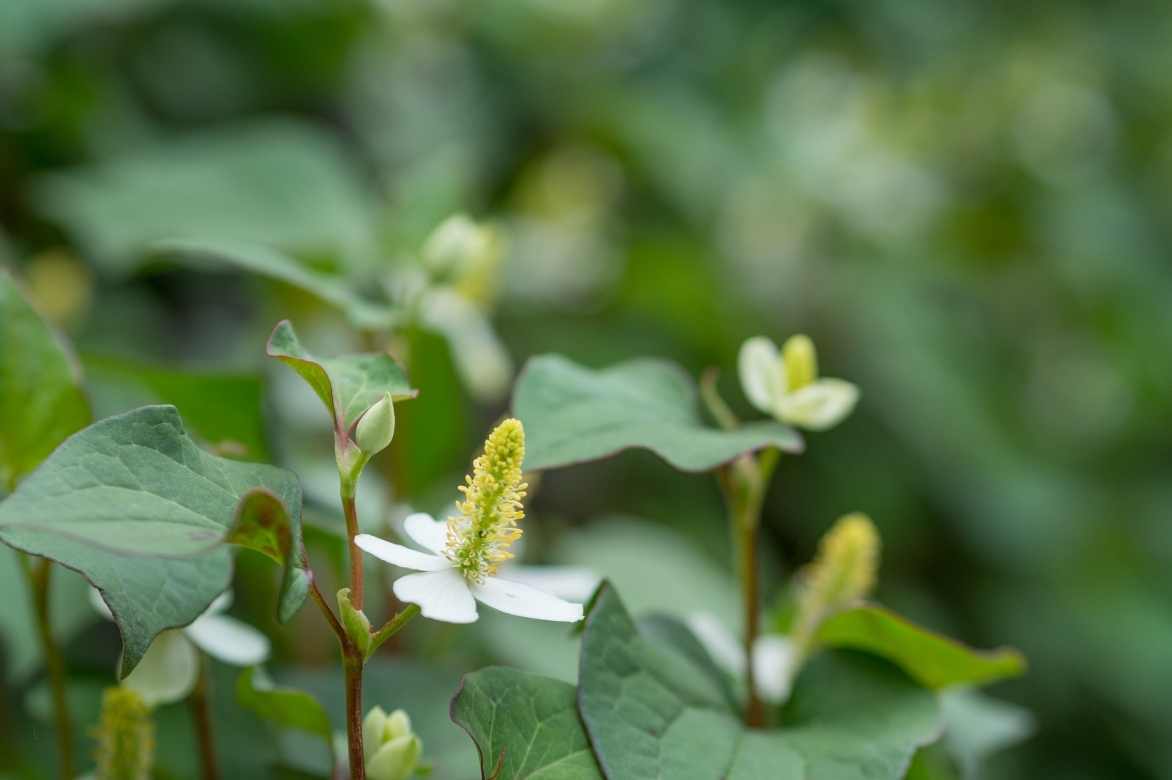
Description and botany
Botanical data
- Latin name Houttuynia cordata
- Family Saururaceae
- Common name Houttuynia
- Flowering June to July
- Height 0.15 to 0.45 m
- Exposure Sun, partial shade
- Soil type Rich, cool to moist
- Hardiness –15 °C
Houttuynia cordata, also known as “Chameleon plant” or “Chinese pepper”, is a perennial groundcover belonging to the Saururaceae family, integrated into the order of Piperales, like pepper plants, peanuts, and wild ginger. Its unpronounceable name originates from the famous Dutch botanist, Marteen Houttuyn.
Houttuynia cordata is the only species represented in the genus. It comes in a few varieties with variegated foliage or double flowers. Native to China and Japan, it is found in the wild in wet and marshy areas, which it colonises using its numerous creeping underground rhizomes. This is why it is considered a semi-aquatic plant that can thrive in shallow water and in waterlogged soils along riverbanks, shores, or water gardens.
This creeping perennial slowly forms a carpet of leaves 30 to 40 cm high and spreads through its rhizomatous roots up to 50 cm wide at maturity. Its rhizomes are fragrant and edible. They have a peppery flavour that is highly valued as a vegetable or condiment in Asian cuisine to flavour dishes.
Houttuynia cordata, as a good groundcover, quickly thickens by rooting in place, with no theoretical limit to its expansion if it is happy. The species can therefore sometimes become invasive in areas that remain moist throughout the year. However, this quality makes it useful for stabilising riverbanks.
In spring, the stems develop delicate deciduous foliage, semi-evergreen in mild climates, which is very ornamental. The leaves unfold into fleshy, aromatic laminae. They are tough, petiolate, fairly broad, and heart-shaped. They are dark green with bronze or grey-green highlights and are veined. Houttuynia cordata ‘Chameleon’ stands out with its beautifully variegated leaves of cream, yellow, pink, and green, as colourful as those of a little chameleon! They emit a slightly peppery orange bark scent when crushed. Its young, highly aromatic leaves are used in Asian cuisine to flavour dishes or to accompany spring rolls, hence its vernacular names “Chameleon Plant” or “Chinese Pepper”.
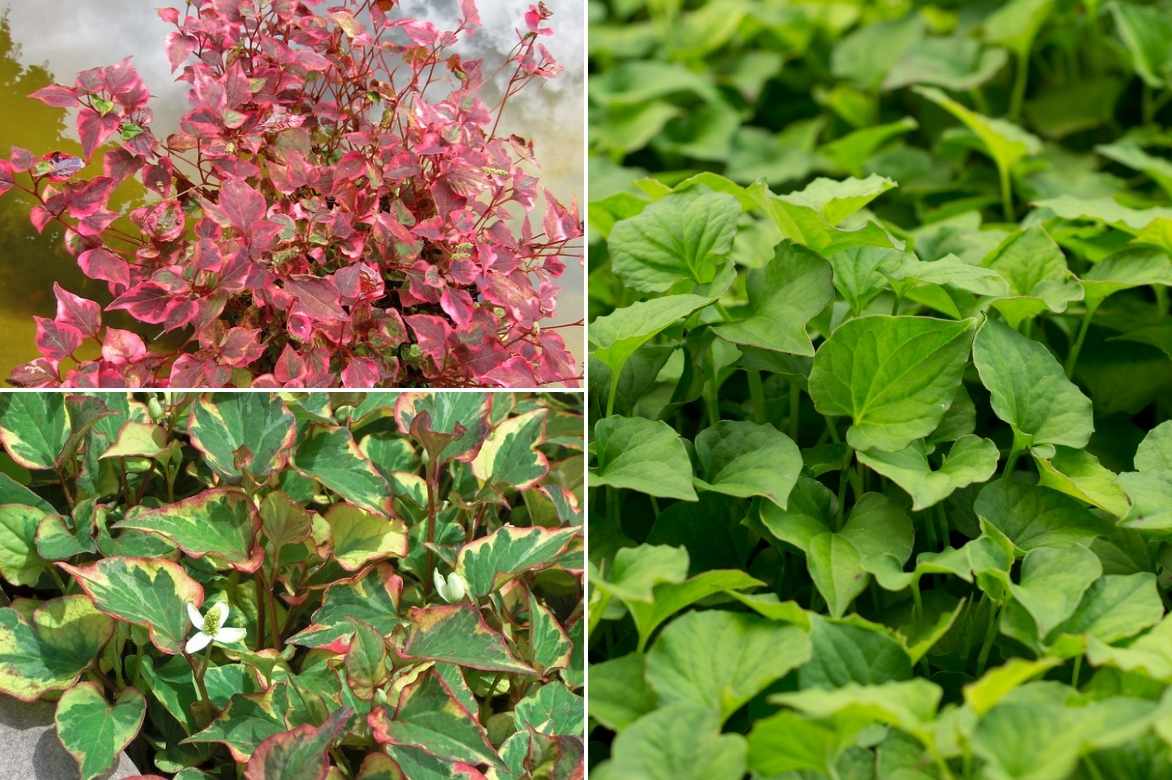
The uniform foliage of Houttuynia cordata, and the colourful varieties on the left, ‘Chameleon’ in autumn (© Leonora Enking) and ‘Tricolor’ (© Andrey Zharkikh)
In summer, from June to August, small clusters of immaculate, fragrant flowers dot the foliage. The flowering takes the form of conical inflorescences: the green-yellow flowers are surrounded by four large white bracts. They resemble the flowers of dogwoods. ‘Flore Pleno’ is a cultivar that stands out for its very double flowers resembling a pagoda.
Houttuynia cordata is a common plant in Asian pharmacopoeia, where it is used for its purifying, diuretic, antibacterial, and antiviral properties, contained in its roots. They are particularly effective for treating respiratory ailments.
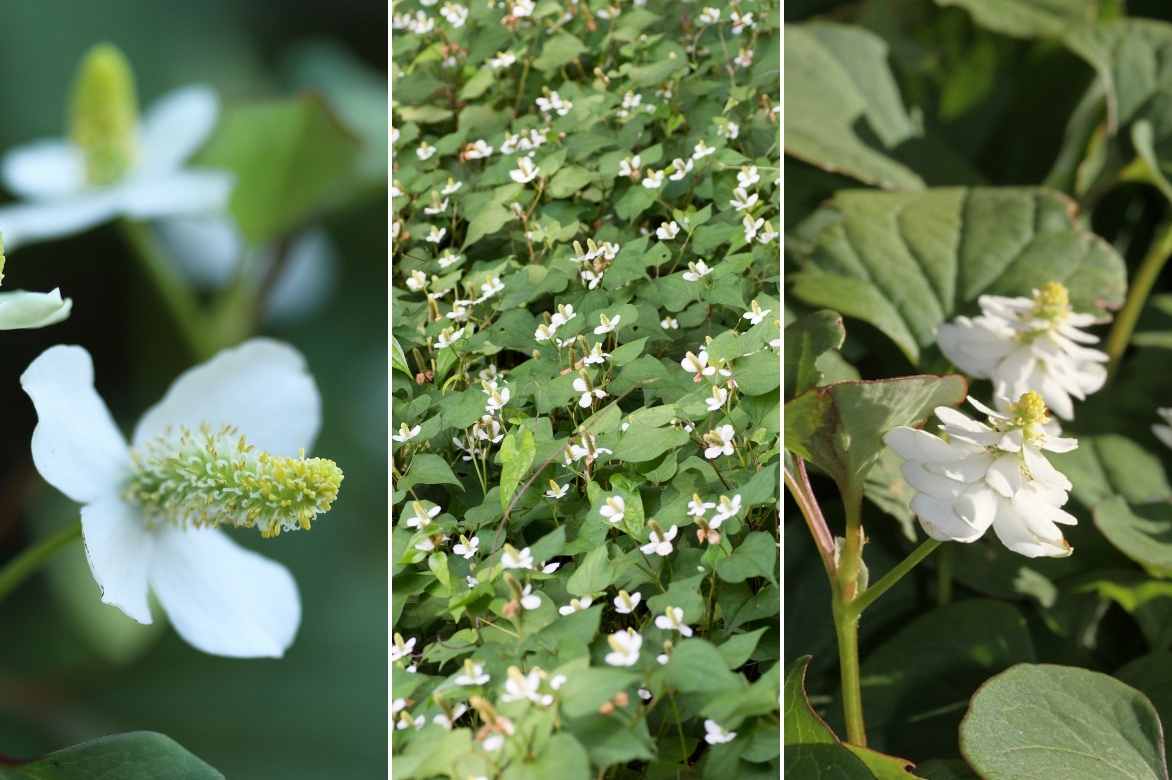
The lovely white flower of Houttuynia cordata, close-up on the left and flowering like a constellation in the middle. On the right, the double-flowered variety ‘Flore Pleno’ (© Andrey Zharkikh)
Read also
12 perennials for heavy, wet soilMain species and varieties
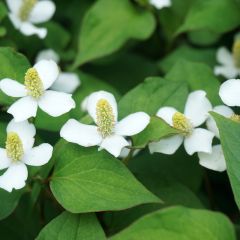
Houttuynia cordata
- Flowering time July, August
- Height at maturity 30 cm
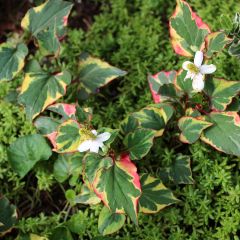
Houttuynia cordata Chameleon
- Flowering time July, August
- Height at maturity 40 cm
Discover other Houttuynia
View all →Available in 1 sizes
Available in 1 sizes
Available in 1 sizes
Planting Houttuynia cordata
Where to plant?
It is hardier than you might think! Resistant to cold down to -15°C, houttuynia can be grown in most regions, only fearing severe frosts, especially if they last. Its foliage may remain evergreen in mild climates. As a wetland plant, it enjoys a good level of humidity. Its cultivation will be more demanding, requiring frequent watering in Mediterranean climates, which can be too dry and hot in summer. It needs soil that is always cool to moist, rich in humus. In fact, any good soil that remains sufficiently cool, even clayey, will suit it. Its roots can tolerate being partially submerged under a few centimetres of water, but caution is advised as they will be more vulnerable to frost in the coldest regions. In harsher climates, it may not withstand severe frosts, which is why in these areas, it is best to grow it in a perforated basket for aquatic planting, to be stored indoors in a bright place and protected from frost during winter.
This plant dislikes overly hot exposures. Plant it in full sun in regions north of the Loire or in partial shade elsewhere. In a partially shaded and cool spot in summer, for example, it will form generous, spectacular leafy carpets. It may eventually adapt to full sun if planted in soil that is always moist. The ‘Chameleon’ variety, however, prefers to be placed in a sunny, wet area to maintain the colour of its leaves; too dense shade would limit its multicoloured variegation.
It thrives in shaded beds, at the edge of a permanently wet path, at the edge of a thicket, and even in a pot where the soil must be kept constantly wet. In the dry shade of trees and shrubs, it will be less invasive, which can be beneficial if you wish to control its spread.
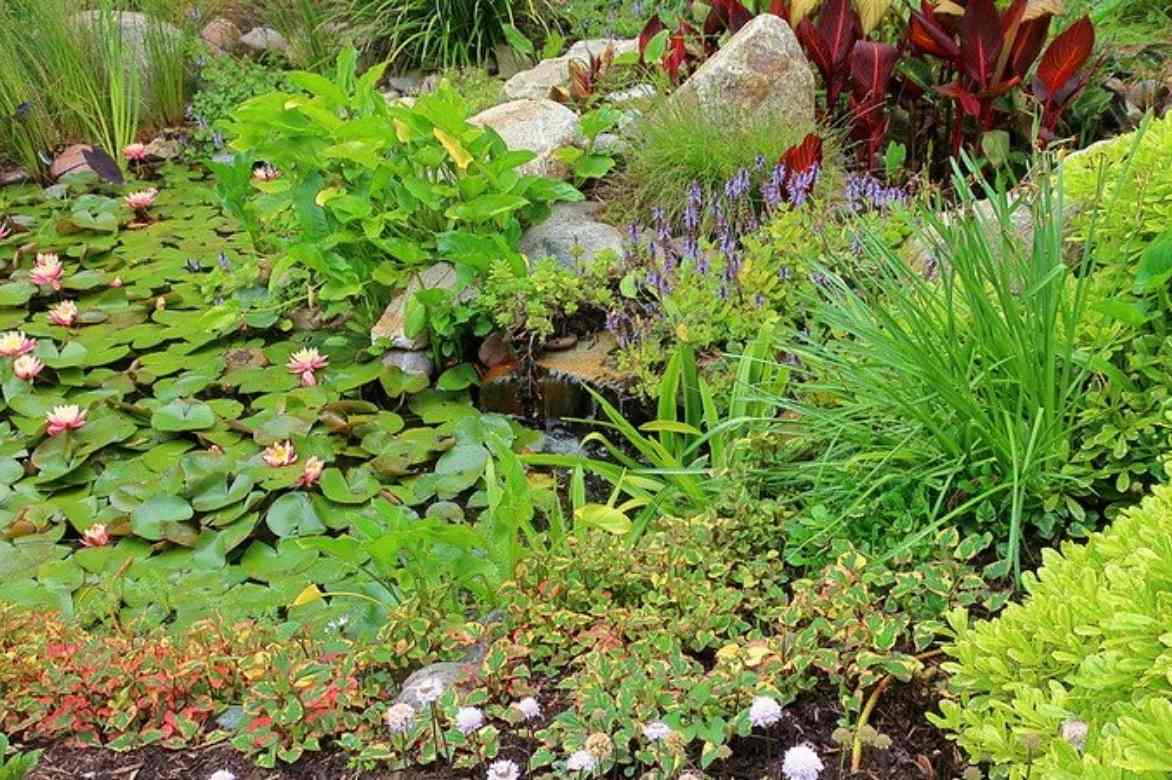
A beautiful wetland bed with Houttuynia ‘Chameleon’ at the edge, along with some Nympheas, Scabious, Plectranthus, and Cannas (© Cultivar 423)
When to plant Houttuynia?
Houttuynia should preferably be planted in spring when the risk of frost has passed.
How to plant?
In the ground
Ensure that the plant never lacks water. Count on 3 to 4 plants per m² to create a beautiful foliage carpet.
- Loosen the soil well and dig a hole 2 to 3 times the volume of the root ball
- Plant in the centre of the hole in a mixture of good soil and rich potting compost
- Backfill and lightly firm down with your foot
- Mulch around the base with organic mulch to retain moisture
- Water generously at planting and then very regularly to keep the soil constantly moist
In a pot
Choose a non-draining zinc pot or basin of at least 50 cm in diameter.
- Plant the root ball in potting compost with water-retaining properties
- Water to keep the substrate constantly fresh
- Bring the pot indoors to protect it from frost in autumn in cold regions
→ Learn more about growing Houttuynia in pots with tips from Gwenaëlle.
Read also
5 groundcovers for clay soilMaintenance and Care
Houttuynia cordata grows without requiring special attention as long as it remains in well-moistened soil throughout the year.
This groundcover cannot tolerate being dry: in pots as well as in the ground, ensure that the substrate is constantly moist, and water accordingly, especially during dry and hot weather. The soil should never dry out completely between waterings.
If you are growing it in a pot, you must be able to meet its water needs.
Install organic mulch (straw, dead leaves, etc.) to limit evaporation in summer and protect its rhizomatous roots from frost in winter, especially in colder regions.
Each spring, add some compost at the base by superficial scratching.
It can become invasive, especially in marshy ground: to limit its spread, regularly remove the suckers.
⇒ Find the right techniques for properly planting a perennial in our video!
Multiplication
If Houttuynia cordata easily naturalises on its own through its underground rootstock, clump division is a good way to propagate this groundcover. Proceed in spring.
- Using a spade, lift a section of the stump
- Divide it into several pieces containing rootstocks
- Replant the sections of rootstock immediately in pots or in the ground
- Keep the soil consistently moist
Pairing ideas
With its solid or variegated foliage, Houttuynia cordata is an essential groundcover to brighten up the cool and damp areas of the garden. Alongside Pachysandra and Asarum, it forms lovely carpets of leaves at the base of bushes or deciduous trees in shaded corners.
At the edge of a semi-shaded bed, it will welcome Hosta tardiana ‘Halcyon’, a Dryopteris affinis, and a Pachysandra terminalis, as well as the delicate flowering of Elf Flowers and periwinkles. It can be paired with spring-flowering shrubs such as magnolias, deutzias, spireas, lilacs, and flowering crab apples.
In a water garden, it will enhance the base of other perennials for wet banks like Acorus, astilbes, sedges, lady’s mantle, and marsh euphorbias.
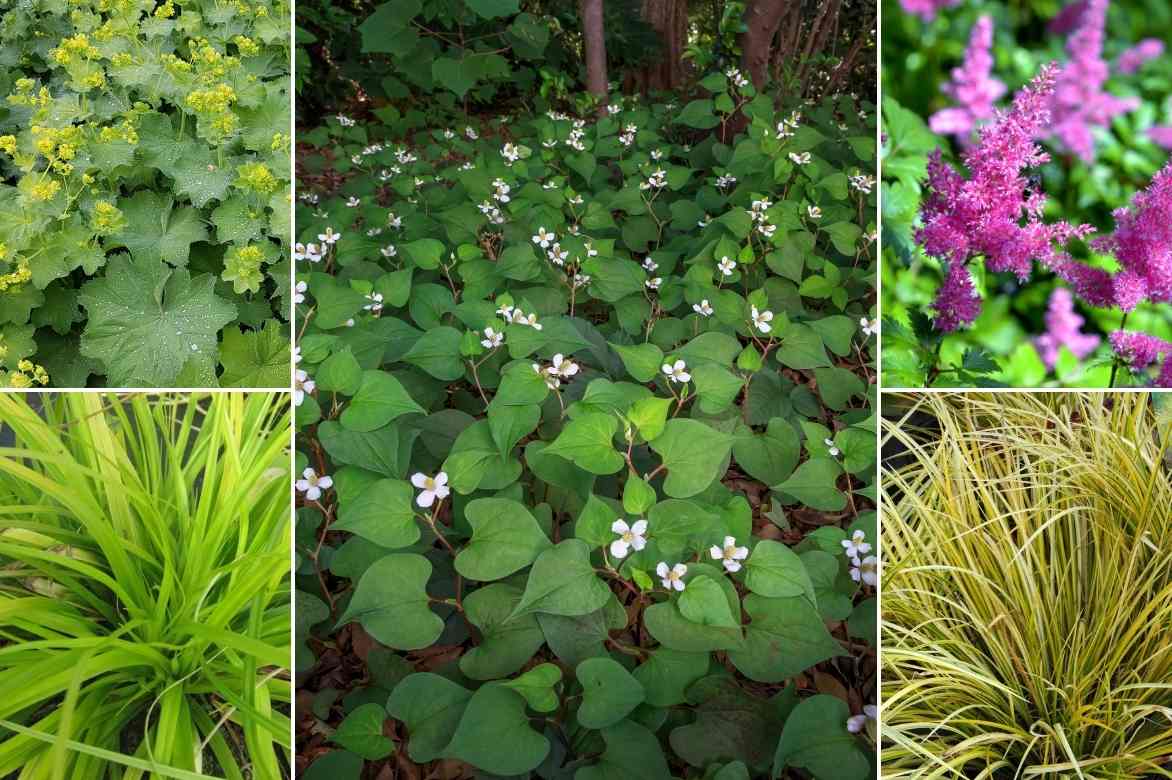
Houttuynia cordata beautifully paired with some lady’s mantle, Acorus gramineus ‘Oron’, astilbes, and Carex oshimensis ‘Everillo’
→ Discover more association ideas with Houttuynia in our article!
Useful resources
- Alternatives to lawn exist!
- Discover our collection of perennial plants for cool to moist soils
- Get inspired by our selection of aquatic plants to enhance your water feature!
- Learn more about edible plants and leaves that can be cooked
- Subscribe!
- Contents
































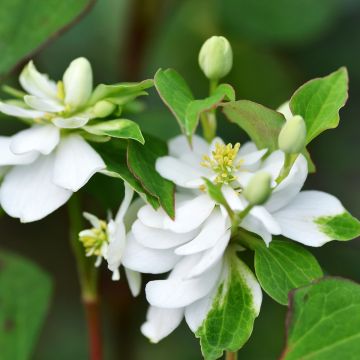

Comments